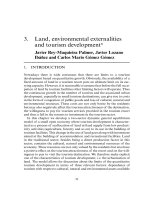THE ECONOMICS OF MONEY,BANKING, AND FINANCIAL MARKETS 458
Bạn đang xem bản rút gọn của tài liệu. Xem và tải ngay bản đầy đủ của tài liệu tại đây (38.19 KB, 1 trang )
426
PA R T V
Central Banking and the Conduct of Monetary Policy
spread among depositors, starting from the agricultural areas, which had experienced
the heaviest impact of bank failures in the twenties. But failure of 256 banks with
$180 million [in U.S. dollars] of deposits in November 1930 was followed by the failure of 532 with over $370 million of deposits in December (all figures seasonally
unadjusted), the most dramatic being the failure on December 11 of the Bank of the
United States with over $200 million of deposits. That failure was especially important. The Bank of the United States was the largest commercial bank, as measured by
volume of deposits, ever to have failed up to that time in U.S. history. Moreover,
though it was just an ordinary commercial bank, the Bank of the United States s name
had led many at home and abroad to regard it somehow as an official bank, hence
its failure constituted more of a blow to confidence than would have been administered by the fall of a bank with a less distinctive name.11
The first bank panic, from October 1930 to January 1931, is clearly visible in
Figure 16-1 at the end of 1930, when there is a rise in the amount of deposits at
failed banks. Because there was no deposit insurance at the time (the FDIC wasn t
established until 1934), when a bank failed, depositors would receive only partial
repayment of their deposits. Therefore, when banks were failing during a bank
panic, depositors knew that they would be likely to suffer substantial losses on
deposits and thus the expected return on deposits would be negative. The theory
of asset demand predicts that with the onset of the first bank crisis, depositors
would shift their holdings from chequable deposits to currency by withdrawing currency from their bank accounts, and c would rise. Our earlier analysis of reserves
suggests that the resulting surge in deposit outflows would cause the banks to protect themselves by substantially increasing their desired reserves ratio r.12 Both of
these predictions are borne out by the data in Figure 16-2. During the first bank
panic (October 1930 January 1931), c began to climb. Even more striking is the
behaviour of r, which more than doubled from November 1930 to January 1931.
The money supply model predicts that when r and c increase, the money supply will fall. The rise in c results in a decline in the overall level of multiple
deposit expansion, leading to a smaller money multiplier and a decline in the
money supply, while the rise in r reduces the amount of reserves available to
support deposits and also causes the money supply to fall. Thus our model
predicts that the rise in r and c after the onset of the first bank crisis would result
in a decline in the money supply a prediction borne out by the evidence in
Figure 16-3. The money supply declined sharply in December 1930 and
January 1931 during the first bank panic.
Banking crises continued to occur from 1931 to 1933, and the pattern predicted by our model persisted: c continued to rise, and so did r. By the end of
the crisis in March 1933, the money supply (M1) had declined by over 25% by
far the largest decline in all of American history and it coincided with the
nation s worst economic contraction (see Chapter 9). Even more remarkable is
that this decline occurred despite a 20% rise in the level of the monetary base
which illustrates how important the changes in c and r during bank panics can
be in the determination of the money supply. It also illustrates that a central
bank s job of conducting monetary policy can be complicated by depositor and
bank behaviour.
11
Milton Friedman and Anna Jacobson Schwartz, A Monetary History of the United States, 1867 1960
(Princeton, N.J.: Princeton University Press, 1963), pp. 308 311.
12
In this Application we use the term desired reserves to mean reserves in excess of required reserves.









